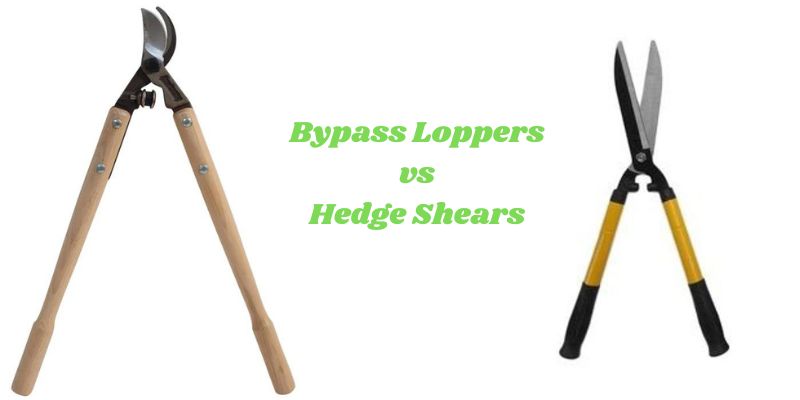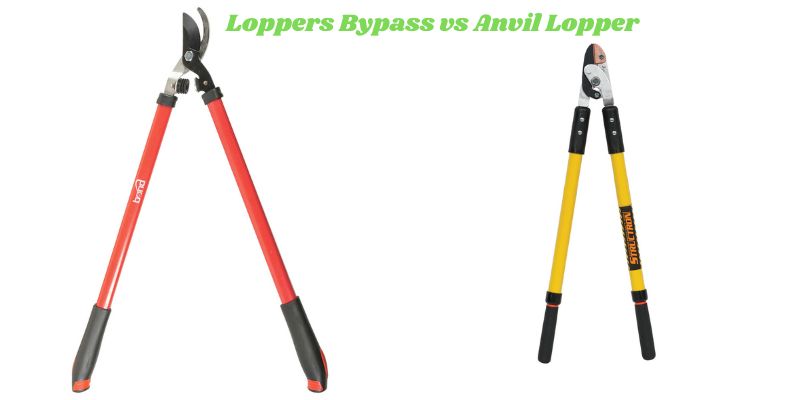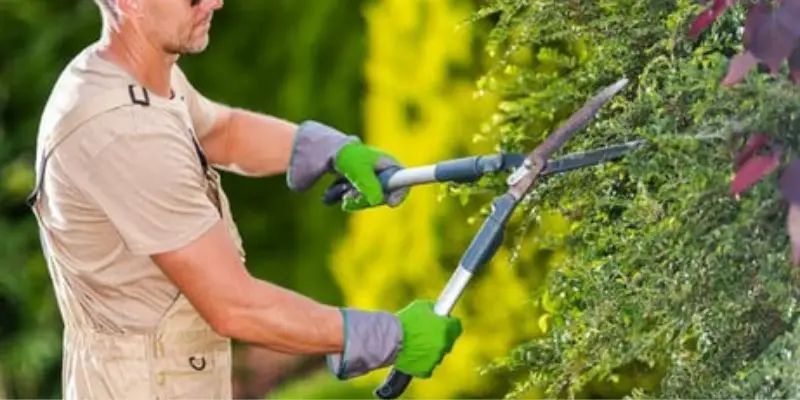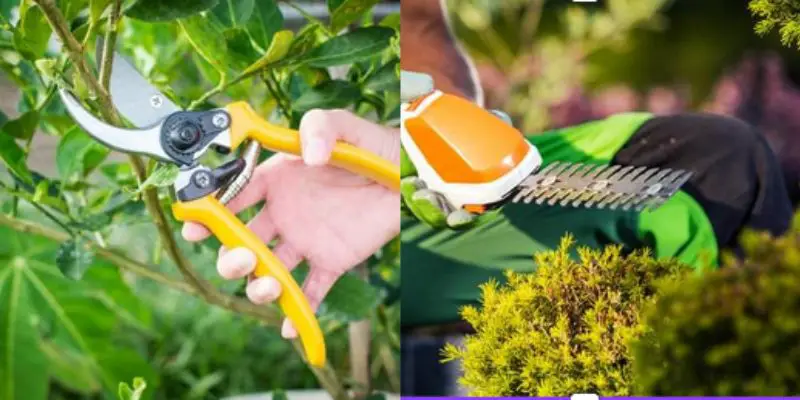As someone passionate about gardening and landscaping for many years now, I’ve had the opportunity to try countless different tools and learn from many mistakes along the way. Pruning tools in particular were a category where I wish I had better guidance when I started. Picking the right equipment can make a huge difference in the effectiveness and joy of a project. Making a choice between bypass loppers vs hedge shears was quite a task.
I clearly remember my early experiments with hedge shears bypass loppers, frustratedly wrestling with branches that were simply too thick or large for the tools I was using. It took many mediocre pruning jobs before I truly understood the strengths and limitations of these versatile pruning options. These days, I make it a point to share my knowledge with other avid gardeners so they don’t have to learn everything the hard way like I did.
In this article, I wanted to offer a practical perspective based on my own experience using bypass loppers and hedge shears over a decade of gardening. Rather than just listing specifications, I’ll explain in plain terms how understanding the differences between these tools has enabled me to choose the right one for countless pruning tasks. I hope that this real-world perspective helps you get better results from your tools and appreciate the intricacies of working with plants.
What is a Bypass Lopper?
A bypass lopper is a long-handled gardening tool with two sharp blades – one stationary and one that moves – used for cutting woody branches and stems up to 3/4 inches in diameter. As the name implies, bypass loppers cut branches using a “bypassing” or scissoring action rather than a chopping motion like regular tree pruners or snips.
When using a bypass lopper, you place the branch between the two blades and squeeze the handles together. The bottom blade remains stationary while the top blade slides past it at an angle to cut the branch cleanly. This bypass or scissoring cut crushes less of the plant material compared to a chopping cut, resulting in cleaner pruning wounds that are less likely to split or crack.
Bypass loppers come in manual and electric models with blade sizes ranging from 4 to 12 inches long. Larger blades allow you to cut thicker branches but make the tool heavier and more tiring to use for extended periods. When choosing a bypass lopper, consider the average branch thickness you need to cut as well as your strength and stamina.
The key advantage of a bypass lopper is its long handles which give you good leverage and reach to prune higher branches without needing a ladder. Its scissoring cut also results in cleaner pruning cuts. However, bypass loppers are slower than hedge shears for cutting large numbers of thin branches and tend to be heavier, and more tiring to use for extensive pruning work.
What are Hedge Shears?
Hedge shears, also called hedge trimmers or pruners, are handheld gardening shears with long, sharp blades. They are used to trim and shape hedges and shrubs by neatly cutting branches and stems up to 1/4 inches thick.
Unlike bypass loppers, hedge shears cut branches using a fast, scythe-like chopping motion by squeezing the looped handle. Some high-end models now feature forged steel or titanium blades with a bypass-cutting action similar to loppers. But most basic hedge shears cut branches via a quick up-and-down chop rather than a true scissoring cut.
Hedge shears come in manual, electric, and battery-powered versions. Manual shears have lightweight aluminum or plastic handles for easier use over extended periods. Electric models offer more power and speed but are heavier to use. Battery-powered shears are rechargeable and cordless for mobility around gardens and large properties.
The key advantage of hedge shears is their speed – you can easily trim entire shrubs and hedges in a fraction of the time compared to a bypass lopper. They are also much lighter weight for tiring jobs. However, their chopping cut is less precise than a lopper’s scissors cut and more likely to damage branches or tear bark on thicker stems.
My Initial Mistakes Choosing between Bypass Loppers vs Hedge Shears
Those early hedge-trimming efforts still make me cringe. Not understanding the capabilities of my basic shears, I’d try to cut woody branches far too thick. With stubborn pressure, it was no surprise the blades would lock up tight or break altogether under the strain.
I must have gone through three or four cheap pairs that first season alone! It was only after mangling a beloved Mexican plum bush that I realized my error – hedge shears are no match for branches over a quarter inch in diameter. A costly lesson, but it drove home the importance of using the right tool for each task.
From that point on, I was determined to give bypass loppers a go. The longer reach and scissors-cut sure seemed smarter for heavy pruning. Unfortunately, I made a similar mistake by choosing loppers also rated too small for my needs. Squeezing fruitlessly as stems wouldn’t budge became all too familiar.
Over time and with much trial and error, I realized the simple thing those early gardeners never told me – pay attention to the branch size a tool is designed to handle! Now when selecting equipment, that rating is my first consideration before anything else.
Figuring Out Applications
Once I’d gotten past matching tools to materials, the next step was learning proper techniques. I’d understood hedge shears were for smaller stems – but what exactly defined “smaller”?
It took shaping several shrubs into unflattering lumps before I calibrated my eyes to accurately gauge 1⁄4 inch diameters or less. Practice and experience have now honed my judgment to a pretty fine point. You won’t catch me attempting to trim much beyond pencil-width stems with shears anymore!
With loppers, I had the opposite problem of being timid and only using them for twigs. But after trying and failing to shear some overgrown privet hedges, I empowered myself to cut burlier 3⁄4 inch branches that required more strength. The results were infinitely better – and a burden had lifted from trying to walk that fine line.
Today, I consider my pruning skills to be fairly seasoned. But I remember humbling starts all too well. When guiding other gardeners now, sharing limitations is vital. It’s the difference between a tool being embraced or abandoned in frustration.
And how often do we need advice tailored to our specific plant materials and property? Not just vague generalizations, but someone spelling out – “for your maple saplings, use these loppers.” That real-world guidance is invaluable to maximize success.
Maintenance Matters
Even as my technique evolved, equipment maintenance was another area of learning. Those student days saw me hacking away with dull, rusty blades and wondering why jobs were such a slog. After each fruitless wrestling match, my tools got shoved back into the shed greasy and uncleaned.
It wasn’t until I participated in a local garden club that I observed another member diligently honing and oiling their stainless steel loppers after a work party. When I asked why they bothered with the upkeep, their response was simple: “Sharp tools make the work a pleasure, dulled ones make it a chore.”
What a lightbulb moment! I rushed home and dug out my neglected pruners and shears, setting to work with an oilstone to restore ragged edges. The difference in cutting ability was night and day – work flew by with less gripping effort. Now properly caring for blades is second nature for me.
Between maintaining sharpness and cleaning after each use, my gear remains in top shape year after year. Reputable manufacturers say with TLC a good pruner will easily outlive its owner. Believing that I don’t hesitate to spend more on quality picks that will serve decades if handled right. Cheap tools demanding replacement each season ultimately cost far more.
Matching Style to Landscape
Of course, actual pruning tasks vary tremendously based on plant type and property scale. Some jobs I face routinely include:
- Regular formal shearing of boxwood hedges bordering our front walkway for a tidy appearance. Hedge shears are essential here.
- Thinning overgrown crape myrtles to open their canopies for more flowers using bypass loppers’ precise cuts.
- Knocking back rampant twining vines smothering trees with loppers’ long reach.
- Sculpting ornamental grasses with shears’ rapid clipping once they fade each winter.
While any pruner could conceivably do any of these, over the years I’ve gravitated towards tools specialized for certain situations. Extensive ground-level shearing is far easier with rotating head trimmers versus hand shears, for instance.
Keeping a solid lopper/shear set indoors means any errant jobs like deadheading houseplants can be addressed during TV binges versus a trip outside. Convenience breeds more spontaneous upkeep – and happier plants.
Final Tips from Experience
For anyone just starting, here are a few final tips from lessons learned the hard way over my years working with bypass loppers and hedge shears:
- Always try loppers first on anything thicker than a pencil before attempting a choppy shearing cut that could damage the plant. Thus, bypass loppers excel at cutting thicker branches 3/4 to 11/2 inches thick. Their scissoring action makes cleaner cuts without tearing bark. Best for selective limb reduction or removal pruning.
- Hedge shears are perfect for shaping, thinning, and evening out shrubs and hedges by snipping many thin branches less than 1/4 inch thick. Much faster than a lopper for large-scale trimming jobs.
- Loppers give you more precise control and leverage for cutting branches above your head or in hard-to-reach areas without a ladder.
- Hedge shears are lightweight and less fatiguing for pruning large numbers of branches at chest height or lower.
- Keep a variety of sizes on hand – long and short handled, from mini snips to full-sized pruning saws. The right size matters almost as much as the tool itself.
- Consider replaceable-blade models as they provide inexpensive blade replacements versus entire tool replacement when dulled.
- Stick with trusted brand names like Felco, Corona, or Fiskars for reliable, precision-engineered homeowner tools at fair prices.
- Safety gear is mandatory – Gloves, glasses, and even chaps for extended use to avoid nicks that invite infection over time.
- Sharpen your blades more regularly than you think is needed, at least seasonally if not monthly for heavy-use tools.
With experience, the challenges I faced as a novice now seem trivial. My sincere hope is this real-world account of lessons learned through triumphs and mistakes provides the guidance I wish I’d had started. Choosing the right pruning tool between bypass loppers and hedge shears makes all the difference between labor and pleasure.

Michael has been in the landscaping world for over 15 years. After obtaining his arborist certification, he dedicated himself to sharing his immense knowledge about plants, trees, and their proper care. Pruning is Michael’s passion. He’s spent decades mastering techniques for timing, methods, and tools. Michael takes great joy in ensuring others learn to maintain beautiful, healthy gardens, and landscapes. Whether through guides, tutorials, or advice, his goal is to equip homeowners and professionals with pruning expertise.
When it comes to choosing the right equipment, Michael is also incredibly knowledgeable. He has used countless pruning tools to discover the most durable, high-quality options. Michael understands what works best in the field. His in-depth comparisons will save you time and money by finding the perfect shears, loppers, trimmers, or saws.
With great respect for horticulture and sustainability, Michael is committed to educating communities. By sharing the insights gained over a lifetime around greenery, he empowers people to steward the planet’s verdant spaces responsibly. Nature is his true passion, and Michael aims to foster others’ love of the living world through his writings.





